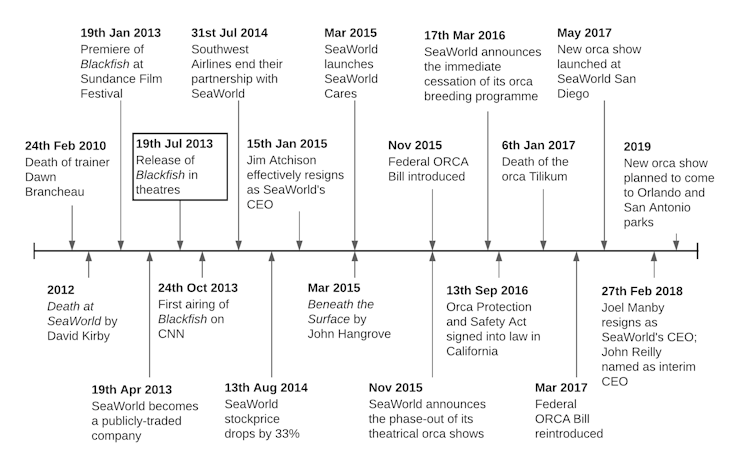After its premiere at the Sundance Film Festival in January 2013, the documentary Blackfish reached nearly 21 million viewers within its first month of airing on CNN. The film tells the bleak story of Tilikum, a performing orca at the US marine park SeaWorld.
After being taken from his mother in the wild at the age of two, Tilikum was held in a tank at SeaLand Canada with two larger females who routinely attacked him. Together the three SeaLand orcas killed a trainer, and Tilikum was transferred to SeaWorld in Orlando on the understanding that he should no longer perform. This advice was ignored, and Tilikum went on to kill two more people, including trainer Dawn Brancheau at SeaWorld in Orlando in 2010.
Blackfish presented Tilikum’s aggression as symptomatic of post-traumatic stress, induced by a life in captivity. This contradicted SeaWorld’s claims that orcas cooperated willingly during each show. The documentary sparked a public outcry against orca captivity.
The hashtag #EmptyTheTanks spread on Twitter and viewers pressured artists into cancelling their shows at SeaWorld and demanded corporate sponsors such as SouthWest Airlines to drop their partnerships with the company. There were also protests outside the park, and in cities worldwide.
In the year following Blackfish’s release, SeaWorld’s attendance dropped by one million visitors. In 2014, the company announced a 84% fall in income and saw its share price drop by 33%. Although SeaWorld attributed this to “the seasonal nature of the business”, the media largely blamed Blackfish. In September 2014, SeaWorld’s shareholders launched a lawsuit against the park, claiming it had misled investors about the effect the documentary would have on its business. In February 2020 SeaWorld agreed to pay out $65m to settle lawsuit claims.
In 2016, SeaWorld announced the immediate end of its orca breeding programme, and in the same year, California passed a ban on captive orca breeding. Five years on, we conducted a study to find out just how influential Blackfish was in bringing about that decision.
Blackfish’s impact
The high number of viewers, social media engagement and press coverage indicate the documentary had a wide reach, but they cannot tell us the role that Blackfish actually played in changing SeaWorld’s policies compared to other factors. For this, we carried out an impact evaluation to disentangle the complex causes.
We used a method from conservation which attempts to understand why a species has recovered in the wild. We compiled a list of 15 potentially important factors that could have led to the change in SeaWorld’s breeding policy and stock market drop, including competition from other marine or theme parks, economic factors that meant guests had less spending money, the 2015 change in SeaWorld’s leadership, and the effect of other media – like the 2015 book Beneath the Surface, written by a former SeaWorld trainer.

We interviewed 26 people with expertise in marine conservation, marine mammal training, zoo and aquarium collections, animal welfare and media communication. This included SeaWorld trainers, though SeaWorld’s leadership refused to take part. We asked them, based on their expert knowledge, whether they thought each of the 15 factors may have affected SeaWorld, and how. We then looked for corroborating evidence.
After eliminating less plausible explanations, our analysis indicated that the negative publicity resulting from Blackfish changed how people viewed orca captivity, and this, rather than a seasonal variation in guest numbers led to a drop in SeaWorld’s visitors and market value. This became particularly clear when we compared SeaWorld’s stock market value over the same period to other amusement parks, such as Disneyland and Universal Studios.
Interviewees identified several reasons why Blackfish had such an impact. The support from major distribution channels like CNN lent credibility to the documentary and allowed it to reach a large audience. As one former employee of SeaWorld said:
Having that movie picked up by CNN gave it credence [and] made people think…this isn’t just a propaganda piece. This is news.
Blackfish also made viewers empathise with Tilikum. One media communication expert screened Blackfish with her students and described its impact:
They get really emotional, very sad or very angry but quite a strong emotional reaction.
The testimonies of the diverse range of experts we interviewed suggested that viewers felt SeaWorld had been dishonest and reckless. As one animal welfare campaigner put it:
It just really offended people that they’ve been lied to for so long… A very severe blow to a company that relies on the goodwill of the public.
The company’s dismissal of Blackfish as propaganda did not help either. One person who worked in the aquarium industry said SeaWorld had been “incredibly slow to anticipate the fallout.”

But our study also made clear that the timing of Blackfish’s release was vital. Various filmed and written works released prior to Blackfish, such as the 2009 documentary The Cove, had slowly influenced public attitudes towards marine mammal welfare and rights.
Blackfish benefited from a perfect storm, building upon decades of animal welfare and animal rights activism against marine mammal captivity.
By exploiting that and creating an emotional bond with viewers through the plight of Tilikum, Blackfish achieved what researchers have so far only speculated about when it comes to the potential of documentaries – sparking widespread activism and, ultimately, change.
"captivity" - Google News
June 21, 2021 at 10:41PM
https://ift.tt/3cWZIWQ
Blackfish: how captive killer whale documentary ended SeaWorld's orca breeding programme - The Conversation UK
"captivity" - Google News
https://ift.tt/3b01anN
https://ift.tt/3dbExxU
Bagikan Berita Ini

















0 Response to "Blackfish: how captive killer whale documentary ended SeaWorld's orca breeding programme - The Conversation UK"
Post a Comment